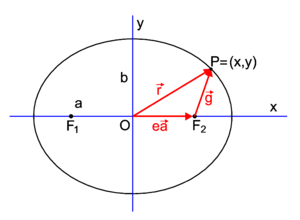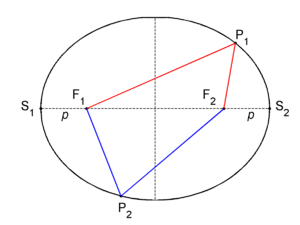Ellipse: Difference between revisions
imported>Paul Wormer No edit summary |
imported>Paul Wormer No edit summary |
||
| Line 11: | Line 11: | ||
</math> | </math> | ||
The horizontal line segment S<sub>1</sub>–S<sub>2</sub> in figure 1, going through the foci, is known as the ''major axis'' of the ellipse. Traditionally, the length of the major axis is indicated by 2''a''. The vertical dashed line segment, drawn halfway the foci perpendicular to the major axis, is referred to as the ''minor axis'' of the ellipse; its length is usually indicated by 2''b''. The major and minor axes are distinguished by ''a'' ≥ ''b''. When ''a'' = ''b'' the ellipse is a [[circle]]—a special case of an ellipse. Clearly both axes are symmetry axes, reflection in either of them transforms the ellipse into itself. Basically, this a consequence of the fact that a reflection conserves (sums of) distances. | The horizontal line segment S<sub>1</sub>–S<sub>2</sub> in figure 1, going through the foci, is known as the ''major axis'' of the ellipse. Traditionally, the length of the major axis is indicated by 2''a''. The vertical dashed line segment, drawn halfway the foci perpendicular to the major axis, is referred to as the ''minor axis'' of the ellipse; its length is usually indicated by 2''b''. The major and minor axes are distinguished by ''a'' ≥ ''b''. When ''a'' = ''b'' the ellipse is a [[circle]]—a special case of an ellipse. Clearly both axes are symmetry axes, reflection in either of them transforms the ellipse into itself. Basically, this a consequence of the fact that a reflection conserves (sums of) distances. The intersection of the axes is the ''center of the ellipse''. | ||
Clearly, the two foci and the points S<sub>1</sub> and S<sub>2</sub> are connected by reflection in the minor axis. Hence the distance |S<sub>2</sub>F<sub>2</sub>| ≡ ''p'' is by symmetry equal to the distance |S<sub>1</sub>F<sub>1</sub>|. The distance of S<sub>2</sub> to F<sub>1</sub> is equal to 2''a'' − ''p''. The distance of S<sub>2</sub> to F<sub>2</sub> is equal to ''p''. By the definition of the ellipse the sum is equal to ''d'', hence | Clearly, the two foci and the points S<sub>1</sub> and S<sub>2</sub> are connected by reflection in the minor axis. Hence the distance |S<sub>2</sub>F<sub>2</sub>| ≡ ''p'' is by symmetry equal to the distance |S<sub>1</sub>F<sub>1</sub>|. The distance of S<sub>2</sub> to F<sub>1</sub> is equal to 2''a'' − ''p''. The distance of S<sub>2</sub> to F<sub>2</sub> is equal to ''p''. By the definition of the ellipse the sum is equal to ''d'', hence | ||
| Line 18: | Line 18: | ||
</math> | </math> | ||
The sum ''d'' of distances from any point on the ellipse to the foci is equal to the length of the major axis. | The sum ''d'' of distances from any point on the ellipse to the foci is equal to the length of the major axis. | ||
==Eccentricity== | |||
{{Image|Ellipse2.png|right|300px|Fig. 2. An ellipse situated such that the major and minor axis are along [[Cartesian coordinates|Cartesian axes]]. The center of the ellipse coincides with the origin O. }} | |||
The eccentricity ''e'' of an ellipse (usually denoted by ''e'' or ε) is the ratio of the distance |OF<sub>2</sub>| to half the length ''a'' of the major axis, that is, {{nowrap|''e'' ≡ <nowiki>|</nowiki>OF<sub>2</sub><nowiki>|</nowiki>/''a''}}. Introducing the vector along the ''x''-axis, | |||
:<math> | |||
\vec{a} \equiv \begin{pmatrix} a \\ 0 \end{pmatrix} | |||
</math> | |||
one finds that ''e'' satisfies the vector relation, | |||
:<math> | |||
e\vec{a} \equiv \overrightarrow{OF}_2 . | |||
</math> | |||
Introduce the following two vectors (cf. figure 2), | |||
:<math> | |||
\vec{r} = \overrightarrow{OP} = \begin{pmatrix} x \\ y \end{pmatrix} \quad\hbox{and}\quad | |||
\vec{g} \equiv \overrightarrow{F_2P} = \vec{r} - e\vec{a}. | |||
</math> | |||
Make now the special choice that the point ''P'' is on the positive ''y''-axis, | |||
:<math> | |||
\vec{r} = \begin{pmatrix} 0 \\ b \end{pmatrix} , | |||
</math> | |||
then the distance of ''P'' to either focus is equal to ''a'' and equal to the length of the vector <math>\vec{g}</math>. For two [[inner product]]s (indicated by a dot) we find, | |||
:<math> | |||
\vec{r}\cdot \vec{a} = 0 \quad\hbox{and}\quad \vec{r} \cdot\vec{r} = b^2. | |||
</math> | |||
Hence, (in fact by the Pythagoras theorem), | |||
:<math> | |||
|\vec{g}\;|^2 = a^2 = (\vec{r} - e\vec{a}\;) \cdot (\vec{r} - e\vec{a}\;) = | |||
b^2 + e^2 a^2, | |||
</math> | |||
so that the eccentricity is given by | |||
:<math> | |||
e = \sqrt{ \frac{a^2-b^2}{a^2}}\quad\hbox{with}\quad 0 \le e \le 1. | |||
</math> | |||
Revision as of 07:27, 29 April 2010
In mathematics, an ellipse is a planar locus of points characterized by having an equal sum of distances to two given fixed points in the plane. In figure 1 two fixed points F1 and F2 are shown, these are the foci of the ellipse. An arbitrary point P1 on the ellipse has distance |F1P1| to F1 and distance |F2P1| to F2. Let d be the sum of distances of P1 to the foci,
then all points of the ellipse have the sum of distances d. Thus, another arbitrary point P2 on the ellipse has distance |F1P2| to F1 and distance |F2P2| to F2. By definition the sum of distances of P2 to the foci is equal to d,
The horizontal line segment S1–S2 in figure 1, going through the foci, is known as the major axis of the ellipse. Traditionally, the length of the major axis is indicated by 2a. The vertical dashed line segment, drawn halfway the foci perpendicular to the major axis, is referred to as the minor axis of the ellipse; its length is usually indicated by 2b. The major and minor axes are distinguished by a ≥ b. When a = b the ellipse is a circle—a special case of an ellipse. Clearly both axes are symmetry axes, reflection in either of them transforms the ellipse into itself. Basically, this a consequence of the fact that a reflection conserves (sums of) distances. The intersection of the axes is the center of the ellipse.
Clearly, the two foci and the points S1 and S2 are connected by reflection in the minor axis. Hence the distance |S2F2| ≡ p is by symmetry equal to the distance |S1F1|. The distance of S2 to F1 is equal to 2a − p. The distance of S2 to F2 is equal to p. By the definition of the ellipse the sum is equal to d, hence
The sum d of distances from any point on the ellipse to the foci is equal to the length of the major axis.
Eccentricity

Fig. 2. An ellipse situated such that the major and minor axis are along Cartesian axes. The center of the ellipse coincides with the origin O.
The eccentricity e of an ellipse (usually denoted by e or ε) is the ratio of the distance |OF2| to half the length a of the major axis, that is, e ≡ |OF2|/a. Introducing the vector along the x-axis,
one finds that e satisfies the vector relation,
Introduce the following two vectors (cf. figure 2),
Make now the special choice that the point P is on the positive y-axis,
then the distance of P to either focus is equal to a and equal to the length of the vector . For two inner products (indicated by a dot) we find,
Hence, (in fact by the Pythagoras theorem),
so that the eccentricity is given by











